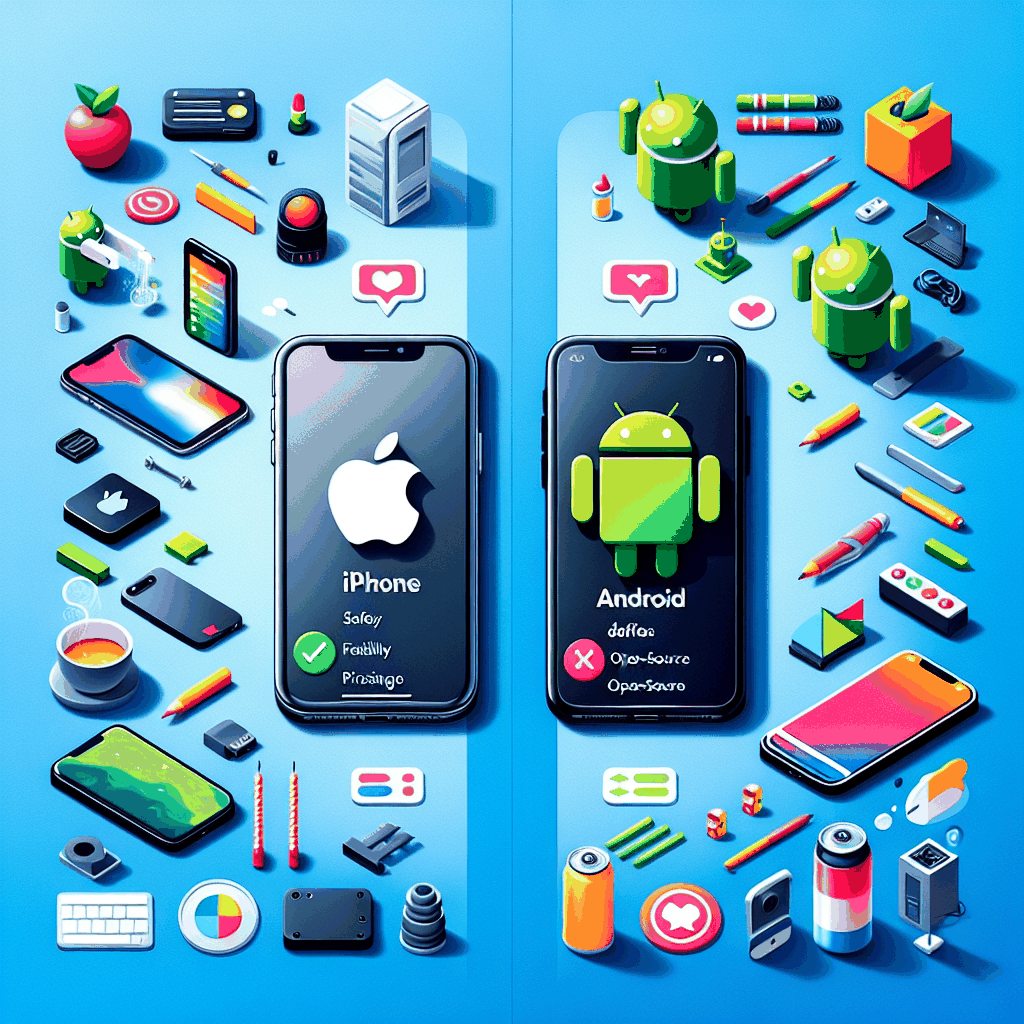Introduction
In this modern era of technology, two mobile platforms reign supreme; the lauded Apple iPhone, and its ubiquitous rival, Android. Our historical foray begins with the illustrious iPhone, born from the vision of renowned tech guru, Steve Jobs, who as the popular folklore suggests, created it on a napkin sketch. Meanwhile, the Android was birthed in the eccentric incubators of Google, where teams of engineers, sustained on a diet of ramen noodles and late night coding sessions, gave life to this open-source phenomenon.
Definition of the Two Platforms
The iPhone is a premium, closed-source platform, fiercely guarded by its creators at Apple, revered for its sleek design and seamless functionality. In stark contrast, Android is the wild child of the tech universe, an open-source platform, a malleable chameleon known for its unrestricted customizability, and democratic availability across various price points.
Brief History
Traced back to 2007, the magnificent iPhone was sired, while 2008 witnessed the begging cries of the Android, both born in tumultuous times, soaked in the hubbub of instigating a tech revolution, with the omnipotent tech-guru Steve Jobs and the casually dressed, programming whiz kids at Google, all set to napalm the world with a mobile revolution.
User Interface
The iPhone interface is an exemplification of minimalistic beauty, blessed with rookie-friendly functionality and stunning aesthetics that would make Picasso weep with joy. Android, on the other hand, is a canvas for customization, a playground for tech-enthusiasts who wish to tailor every nook and cranny of their mobile experience, a tool for the rebellious ones, who believe smartphones should not be rigid in their uniformity but dynamic and modifiable.
Aesthetics and usability on iPhone
The iPhone, the celebrated Mona Lisa of the tech world, is a symphony of fluid user experience, harmoniously bound by intuitive gestures and visually appealing iconography. Its eye-candy simplicity is a waltz on the touch-screen for even tech-neophytes, making the act of engaging with apps and services nothing shy of a digital ballet.
Customizability on Android
Entering the world of Android is like stepping into an artist’s studio, with its array of tools waiting for the masterstroke of personalization, offering unparalleled possibilities for the individualistic tech-connoisseur.
App Store vs Google Play Store
Amidst the digital Game of Thrones, the App Store and Google Play Store serve as the twin pillars to the iPhone and Android empire respectively. In this relentless duel, iPhone’s App Store is the class-act aristocrat, housing meticulously curated apps, while the Google Play Store is the bustling marketplace, teeming with diversity but also questionable quality at times.
Range of Apps
The choice of apps in the two stores is like choosing between a densely populated urban market (Android) brimming with alternatives, and an exclusive boutique (iPhone) with fewer but meticulously crafted options.
Quality of Apps
In terms of app quality, the iPhone, akin to a Michelin-starred chef, assumes an autocratic stance of quality over quantity, painstakingly vetting every app; whereas the democratic Android, sometimes lapses into questionable territories, akin to a street food bazaar, with culinary disasters lurking amongst the deliciously diverse offerings.
Security
When it comes to the Fort Knox that is mobile security, the iPhone is an obdurate tyrant, jealously guarding its inner workings with impenetrable protocols. The Android, however, in its spirited quest for freedom, caters to a more laissez-faire security approach, sometimes landing in the rogue realm of malware and viruses.
Comparison of security measures on iPhone
The iPhone, akin to a Spartan warrior, meticulously fortifies its hardware and software with probable world’s highest encryption standards and least amount of documented vulnerabilities. On this Orwellian fortress, apps and third-party installations live a caged existence, like inmates in an Alcatraz for code, scrutinized under Apple’s hawk eye, rendering a solid imperviousness to the threat of malware and cyber-attacks.
Security aspects on Android
Android, on the other hand, is like a bohemian hostel, its open-source charm, enticed by freedom and accessibility, falling prey to seedy malware and rogue applications. It doesn’t pick its guests like the stringent iPhone does. Instead, it subscribes to the adventurous philosophy of ‘the more, the merrier’. This open-door policy invariably allows threats to seep in, like the occasional pickpocket in a crowded train. However, the platform does take measures to retain a semblance of order. With Google’s Play Protect service, it tries to function as an impromptu bouncer, scanning apps for harmful behavior, a noble attempt, but pales in comparison to iPhone’s totalitarian vigilance.
Conclusion
Embarking on the concluding notes of our technological opera, we find Apple and Android, the two titans locked in an endless waltz of rivalry, encapsulating the quintessential tale of stability versus customization, of exclusivity countering universality. As for the final oracle for this digital duel, it inevitably leans on the preferences of you, the audience; the iPhone, with its sleek uniformity, and dictatorial reliability, might woo the minimalistic pragmatist, while Android, with its sprawling customization and jovial democratic vibe, might serenade the adventurous soul nurturing the love for personalization.
Summary of main comparison points
Our digital gladiators have sparred on three primary arenas – UI experience where iPhone’s elegant minimalism competes against Android’s boundless customization, the App Stores where iPhone’s elite, refined collection wrestles with Android’s bustling, diverse array, and finally security, witnessing iPhone’s stringent measures paralleling Android’s more flexible, albeit riskier protocols.
Personal opinions and recommendations
While the polished Apple devotee might smirk at my suggestion, I can’t help but tip my hat towards the audacious Android, with its intoxicating mix of democratic vibrancy and infectious free-spirit ethos, a slightly risky affair I admit, but indeed, a thrilling gamble worth taking!
SEO Powered ByBreakout Content AI
